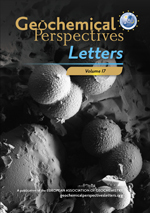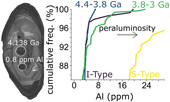 | Emergence of peraluminous crustal magmas and implications for the early Earth Abstract: Detrital zircons from the Jack Hills (JH) metasedimentary belt of Western Australia are a record of the first ∼1.5 billion years of Earth history and can be used to help reconstruct the conditions of crust formation and secular changes therein. Beginning as early as ca. 4.3 Ga, but becoming more pronounced in the mid-Archean, a peraluminous signature begins to emerge from the JH zircon record. Combined with trace elements (P, REEs) and Ti-in-zircon thermometry, this increase in peraluminosity is likely the result of deep (>7 kbar) partial melting of hydrous mafic protoliths or partial melting of metasedimentary source material. In a geodynamic context, these results may suggest a gradual shift from a vertical tectonic regime toward a horizontal tectonic regime with potential subduction-like or collisional processes creating the necessary conditions for peraluminous melt generation beginning locally at least by ∼3.6 billion years ago (Ga). |
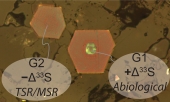 | SHRIMP 4-S isotope systematics of two pyrite generations in the 3.49 Ga Dresser Formation Abstract: The 3.49 Ga Dresser Formation has been considered to host evidence of the earliest microbes metabolising sulfur species on Earth. However, previous bulk analyses and in situ measurements conclude disparate metabolisms based on opposite Δ33S1. This study first established the generations of pyrite growth, and then measured the multiple sulfur isotopes in situ using Sensitive High Resolution Ion MicroProbe-Stable Isotope analyses. Two main generations of pyrite were revealed based on core-rim textures and multiple sulfur isotopic compositions: Δ33S-positive Generation One (G1) and δ34S- and Δ33S-negative Generation Two (G2). In the chert-barite unit, the diluted Δ33S-positive and Δ33S-negative photochemical products were mainly sequestered in G1 and barite, respectively. G2 were formed via the sulfide pathway with sulfur derived from sulfate reduction and magmatic H2S. The δ34S-Δ33S-Δ36S1 systematics suggests an abiological origin for G1, and thermochemical and possible (minor) microbial sulfate reduction for G2. 1Δ33S and Δ36S quantify the magnitudes of sulfur mass-independent fractionations (S-MIFs) during a reaction, which are the deviations of the 34S/32S, 33S/32S, and 36S/32S isotopic ratios from those expected solely based on their mass differences (see section 3.2 in the Supplementary Information). |
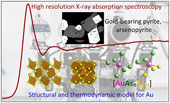 | An arsenic-driven pump for invisible gold in hydrothermal systems Abstract: Pyrite (FeS2), arsenopyrite (FeAsS) and löllingite (FeAs2) are exceptional gold concentrators on Earth; yet the exact redox and structural state of this “invisible” gold and the forces driving its intake and release by these minerals remain highly controversial. Here we applied high resolution X-ray absorption spectroscopy to Au-bearing pyrite and iron sulfarsenides from hydrothermal deposits and their synthetic analogues. We show that Au preferentially enters octahedral Fe structural sites [Au(As,S)6] enriched in As, by forming respectively [AuAs1–3S5–3], [AuAs3S3⋯AuAs6] and [AuAs6] atomic units in arsenian pyrite (>0.1–1.0 wt. % As), arsenopyrite and löllingite, implying a formal oxidation state of AuII in the minerals. In contrast, in As-poor pyrite, Au is dominantly chemisorbed as [AuIS2] moieties in much lower concentrations. Combined with experimental data on Au mineral-fluid partitioning, our findings imply a universal control exerted by arsenic on gold incorporation in iron sulfides and sulfarsenides via coupled Au-As redox reactions. These reactions account for the observed variations in invisible gold contents in the minerals from different hydrothermal deposit types and enable quantitative prediction of iron sulfarsenide ability in controlling gold concentration and distribution in hydrothermal systems. |
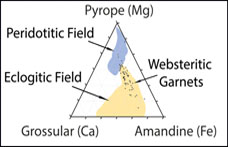 | A genetic metasomatic link between eclogitic and peridotitic diamond inclusions Abstract: Diamond inclusions sample the otherwise inaccessible archive of Earth’s deep interior. The geochemical and petrological diversity of diamond inclusions reflects either pre-metasomatic upper mantle heterogeneity or metasomatism coeval with diamond formation. We focus on the origin of lithospheric garnet and clinopyroxene inclusions by simulating metasomatic reactions between eclogitic fluids and mantle peridotites at 5 GPa, 1000 °C, and across a range of redox conditions (logfO2 = −1 to −6 ΔFMQ). Our results demonstrate that fluid-rock interaction can result in the formation of eclogitic, websteritic, and peridotitic silicates from a single fluid during a single diamond-forming metasomatic event. Ergo, the petrogenesis of diamond and their inclusions can be syngenetic, and the petrological diversity of diamond inclusions can reflect metasomatism coeval with diamond formation. Furthermore, during the metasomatism, refractory peridotite can be converted to fertile websterite which could become a pyroxenitic mantle source for oceanic basalts. |
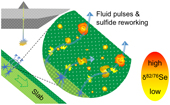 | Selenium isotope evidence for pulsed flow of oxidative slab fluids Abstract: Isotope systematics of the redox sensitive and chalcophile element selenium (Se) were investigated on exhumed parts of subducted oceanic lithosphere to provide new constraints on slab dehydration conditions during subduction. The samples show increasing δ82/76SeNIST3149 with higher abundances of fluid mobile elements, comprising a larger range (−1.89 to +0.48 ‰) than that of mantle (−0.13 ± 0.12 ‰) and altered ocean crust (−0.35 to −0.07 ‰). Our data point to pronounced, local scale redox variations within the subducting crust, wherein oxidative fluids dissolve sulfides and mobilise oxidised Se species. Subsequently recrystallising sulfides preferentially incorporate isotopically lighter, reduced Se, which shifts evolving fluids and late stage sulfides to higher δ82/76SeNIST3149. Redistribution of Se by repeated cycles of sulfide reworking within the subducted crust can be reconciled with episodes of oxidised fluid pulses from underlying slab mantle in modern subduction zones. |
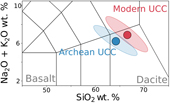 | The composition and weathering of the continents over geologic time Abstract: The composition of continental crust records the balance between construction by tectonics and destruction by physical and chemical erosion. Quantitative constraints on how igneous addition and chemical weathering have modified the continents’ bulk composition are essential for understanding the evolution of geodynamics and climate. Using novel data analytic techniques we have extracted temporal trends in sediments’ protolith composition and weathering intensity from the largest available compilation of sedimentary major element compositions: ∼15,000 samples from 4.0 Ga to the present. We find that the average Archean upper continental crust was silica-rich and had a similar compositional diversity to modern continents. This is consistent with an early Archean, or earlier, onset of plate tectonics. In the Archean, chemical weathering sequestered ∼25 % more CO2 per mass eroded for the same weathering intensity than in subsequent time periods, consistent with carbon mass balance despite higher Archean outgassing rates and more limited continental exposure. Since 2.0 Ga, over long (>0.5 Gyr) timescales, crustal weathering intensity has remained relatively constant. On shorter timescales over the Phanerozoic, weathering intensity is correlated to global climate state, consistent with a weathering feedback acting in response to changes in CO2 sources or sinks. |
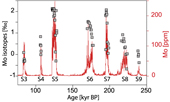 | Molybdenum isotope constraints on the temporal development of sulfidic conditions during Mediterranean sapropel intervals Abstract: Mediterranean sapropels represent some of the largest scale deoxygenation events in recent Earth history. Here, we use high resolution Mo isotope data for seven such events (sapropels S3 to S9) to semi-quantitatively constrain past H2S concentrations using a new interpretive framework. Bottom water H2S was present for all studied sapropels, but the extent of redox changes varied considerably between them, the ultimate driver likely being variations in monsoon strength. Near-quantitative removal of Mo (δ98Mo > 2 ‰) during deposition of sapropels S5 and S7 suggests predominantly highly sulfidic conditions with long deep water residence times, comparable to the modern Black Sea, whereas considerably lower δ98Mo values for sapropels S3, S4, S8, and S9 (−0.4 to +0.9 ‰) imply mildly euxinic conditions only (0 < H2S < 11 μmol/L). The high resolution data reveal consistent temporal patterns that track the development of basin restriction and euxinia over several kyr. These observations illustrate how Mo isotopes can provide quantitative constraints on basin wide redox changes on relatively short time scales. |
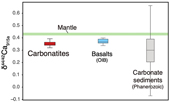 | Ca isotope systematics of carbonatites: Insights into carbonatite source and evolution Abstract: Carbonatite, an unusual carbonate-rich igneous rock, is known to be sourced from the mantle which provides insights into mantle-to-crust carbon transfer. To constrain further the Ca isotopic composition of carbonatites, investigate the behaviour of Ca isotopes during their evolution, and constrain whether recycled carbonates are involved in their source regions, we report δ44/42Ca for 47 worldwide carbonatite and associated silicate rocks using a refined analytical protocol. Our results show that primary carbonatite and associated silicate rocks are rather homogeneous in Ca isotope compositions that are comparable to δ44/42Ca values of basalts, while non-primary carbonatites show detectable δ44/42Ca variations that are correlated to δ13C values. Our finding suggests that Ca isotopes fractionate during late stages of carbonatite evolution, making it a useful tool in the study of carbonatite evolution. The finding also implies that carbonatite is sourced from a mantle source without requiring the involvement of recycled carbonates. |
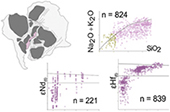 | Integration of elemental and isotope data supports a Neoproterozoic Adamastor Ocean realm Abstract: A robust elemental and isotopic dataset from Neoproterozoic igneous rocks discloses protracted consumption of oceanic lithosphere in the 3,000 km long orogenic system of southeastern South America. Time dependent isotopic variation trends suggest that Tonian-Cryogenian magmatic rocks formed in intra-oceanic supra-subduction settings, followed by Ediacaran magmatic arc building along Andean-type continental margins. Tectonic slices of basic-ultrabasic rocks associated with deep sea and exhalative rocks are interpreted as remnants of obducted oceanic lithosphere. Protracted closure of the oceanic realm resulted in a Himalayas-sized orogenic belt during Ediacaran-Cambrian collision, as recorded by voluminous aluminum-rich syn-collisional granites followed by post-collisional intrusions. The duration and rates of crust forming processes in island arc, continental margins and collisional settings imply that a vast Adamastor oceanic realm was consumed to form western Gondwana. |
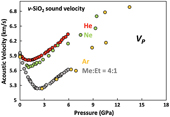 | Noble gas incorporation into silicate glasses: implications for planetary volatile storage Abstract: Incorporation of small molecules in silicate melts may provide an important mechanism for storing noble gases in the deep Earth, yet the means by which chemically inert noble gases enter and are retained in silica-based materials is not understood. High pressure, room temperature sound velocity measurements on silica and natural basalt glasses in different pressure-transmitting media reveal that neon enters the structure of silicate glasses and enhances their elastic strengths, whereas an ethanol-methanol mixture does not. Combined with literature data, we found the incorporation of small molecules into silica and basalt glasses is controlled by the void size distribution of the glass and size of the molecules. Pressure primarily reduces the size of noble gases, thereby increasing their solubilities in silicate melts and glasses. |
<< Previous issueNext issue >>





